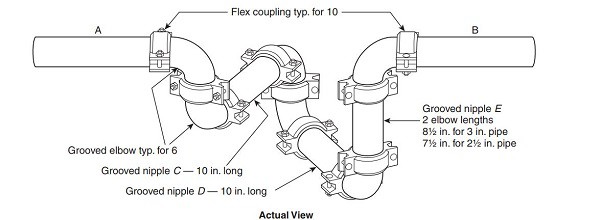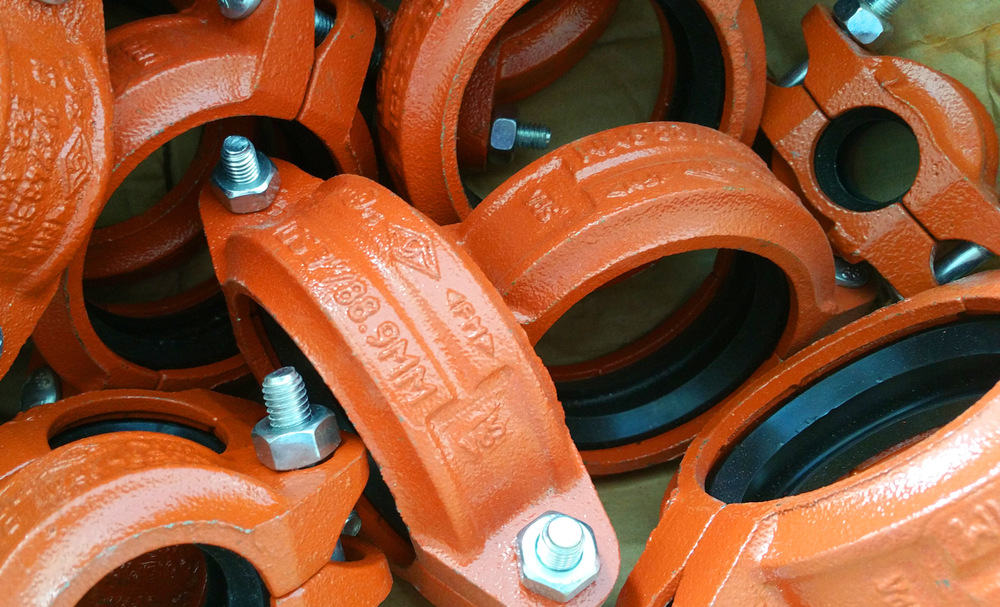Why choose rigid or flexible couplings for fire sprinklers and other fire protection systems?
Grooved pipe couplings are some of the most important equipment in fire protection, allowing quick and water-tight connections without pipe threads, flanges, or welding. Instead, installers simply butt the ends of pipes together and seal them with a gasket and clamp.
But there are also two kinds of grooved couplings that serve different purposes. Rigid grooved couplings don’t allow much movement and serve as a standard pipe joint. But for situations where some give is needed—specifically, seismic protection of fire sprinkler systems—flexible grooved couplings are the solution.
This article reviews the basics of grooved pipe couplings and details the differences between a rigid and flexible coupling. We also explain when and how NFPA 13: Standard for the Installation of Fire Sprinkler Systems (2022 edition) requires using flexible couplings for seismic protection.
Shop our selection of rigid grooved couplings and other fittings for your pipe-joining needs. Looking for flexible couplings? Contact QRFS today for a quote or to place a special order.
Rigid coupling vs flexible coupling: similar parts but different roles
Grooved couplings are the fastest way to join pipes. And the technology is simple. Earnest Tribe, the founder of Victaulic, patented the grooved pipe joint in 1919 after developing the tech to meet wartime needs. Grooved couplings avoid the need for welding or other joint types. Instead, they use three components: 1) pipe with grooved ends, 2) synthetic rubber gaskets, and 3) c-shaped clamps.
To form a joint, installers butt two pipes with grooves cut in the ends together. A lubricated gasket slips over the pipe ends so that it overlaps the joint. And a c-shaped clamp or housing fits into the grooves of the pipe, compressing and stabilizing the gasket. This video from Victaulic shows how the joints are made:
But as we mentioned, there are two kinds of grooved joints. So, what’s the difference between a rigid and flexible coupling?
From the outside, you can’t look at a grooved coupling and know whether it’s rigid or flexible; they look the same. The difference is on the inside of the joint in the way that the gasket, groove, and clamp fit together. A rigid clamp permits next to no separation, rotation, or angular movement. But a flexible coupling permits some movement and space without compromising the seal or damaging the pipe. NFPA 13 officially describes how much flexibility is allowed:
3.3.83 Flexible Coupling. A listed coupling or fitting that allows axial displacement, rotation, and at least 1 degree of angular movement of the pipe without inducing harm on the pipe. For pipe diameters of 8 in. (200 mm) and larger, the angular movement is permitted to be less than 1 degree but not less than 0.5 degree.
Key to this definition is the term “listed.” A testing laboratory such as UL or FM Global must verify that a flexible grooved fitting meets specific flexibility, seal, and strength requirements before it can be used in a fire sprinkler system.
This diagram from Bentley Communities helps illustrate the physical difference between the two types of joints:

Almost all grooved couplings use rigid joints because rigid, unmoving joints are desired for most situations. But flexible couplings, while less common, do play essential roles in seismic protection for fire sprinkler systems that require an earthquake-resistant design.
The flexible coupling in fire protection: a seismic safeguard
Some fire sprinkler systems require design measures to protect them from earthquake damage. In our overview of the principles of seismic protection, we explain the two basic techniques for protecting pipes from damage: adding rigidity and adding flexibility. Rigidity, in the form of seismic bracing, ensures that pipe moves with a building in an earthquake instead of shaking violently and breaking loose.
Flexibility, on the other hand, prevents damage to pipes caused by differential movement. When an earthquake’s powerful p-waves shake a building, the whole structure can move—but not always all at the same time. For example, the ground floor moves first in tall buildings, and the top floors lag behind. This wave-like motion that resembles a slinky is called “story displacement.” And the differential movement it causes in various onsite equipment can snap fire sprinkler pipes.
Flexible couplings prevent damage to pipes by allowing movement
The solution to this problem is flexibility, which designers can achieve with flexible grooved couplings. The modest ‘give’ allowed by these devices can prevent pipes from being damaged in an earthquake.
NFPA 13 requires grooved flexible couplings for pipes that are 2 ½” or larger (Section 18.2.1) in certain buildings that fall into specific design categories (SDC). And because story displacement significantly affects risers, most of these rules involve risers (18.2.3.1):
- Within 2 feet of the top and bottom of each riser, with some exceptions for short risers
- Within 1 foot above each floor in multistory buildings (except roofs)
- Within 2 feet below each floor in multistory buildings
- Within 1 foot of concrete or masonry walls, with exceptions made where adequate clearance is provided
- Within 2 feet of building expansion joints
Flexible couplings are also required at horizontal tie-ins to the riser (18.2.3.2) and the connection of drop-pipes (18.2.4).
Flexible couplings allow flexibility when two structures move independently. But don’t forget that bracing, which ensures pipe moves with a building, is the other core technique of seismic design. Flexible couplings can work against this objective by reducing rigidity. So, to compensate, NFPA 13 says that flexible couplings should only coincide with structural separations (18.2.2). And where they are used outside the explicit instructions, extra sway braces are needed (18.2.3).
In our previous blogs, you can learn more about the principles of sway bracing and how cable sway braces work.
Flexible couplings in seismic separation assemblies
Flexible couplings can also be used to construct seismic separation assemblies. These pipe assemblies are used where horizontal pipe must cross an engineered gap, called a seismic joint, between two structures.
The “structures” can be two independent buildings or two freestanding wings of the same building. When a pipe crosses a gap like this, NFPA 13 requires seismic separation assemblies (18.3.1) to keep it from breaking when the two structures move during an earthquake.
There are two ways to build a seismic separation assembly (18.3.2). One approach uses flexible pipe arranged in a u-bend. The other involves a zig-zag pattern of flexible grooved elbows. Either way, the assembly should accommodate a wide range of motion in three directions: the complete closing of the gap between the structures, a doubling of the gap, or lateral movement equal to the size of the gap.

Couplings: a small part with a crucial role in fire protection
You need a stiff joint for the vast majority of sprinkler pipe connections. That’s why most grooved pipe joints use rigid couplings. But sometimes, flexibility is necessary for seismic design, and the extra range of motion provided by flexible couplings can prevent earthquake damage.
Be sure to check your local codes, including whether a building falls within a seismic design category (SDC) that requires special equipment to keep fire protection systems safe. A qualified system designer must make this determination. Regardless of what you need, QRFS can provide:
- Rigid grooved couplings and pipe fittings — in stock and online.
- Flexible couplings on request; contact us today to place a special order.
If you have questions or need help finding the part you need, call us at (888) 361-6662 or email support@qrfs.com.
This blog was originally posted at blog.qrfs.com. If this article helped you, check us out at Facebook.com/QuickResponseFireSupply or on Twitter @QuickResponseFS.



I need flexible coupling
Sir — QRFS carries some grooved flexible couplings that you can view here — if you need something different, please email support@qrfs.com and describe the item you need. Thanks!
I can’t find the code or Standard details for installation of flexible couplings (pipe expansion joint ) in horizontal pipes at building expansion joint, like 6″ we need to fix 7 pcs of flexible Coupling and 4″ we need to use 10 pcs
Arafeh — Please specify the context in which the flexible couplings will be installed (e.g., wet fire sprinkler system in such and such building type), and we’ll see if we can point you in the right direction. Thanks.
How to calculate the number of flexible couplings required in 100mm or 150mm expansion joints between buildings? Kindly clarify.
Mohideen — we’re unsure of the exact nature of your question and the precise answer; generally, they’re needed wherever pipes of that size have a junction representing an expansion joint (“flexure joint” in NFPA 13) in a seismically designed system. From the 2022 edition of NFPA 13:
Otherwise, the exact number of couplings and expansion joints, plus other measures, depends on a professional analysis, as the expanded commentary for section 18.2.2 explains:
And note that systems with a greater number of flexible couplings than NFPA 13 requires also need sway bracing (18.2.3). In short, a qualified “design professional in charge” should assess the specific situation. Thanks for reading!